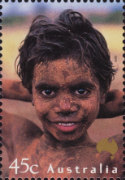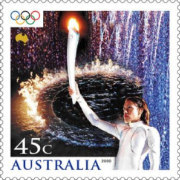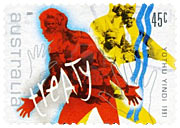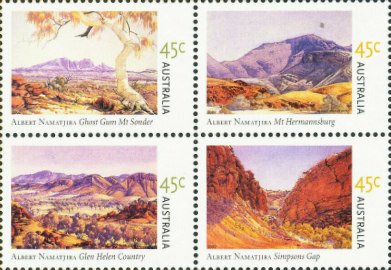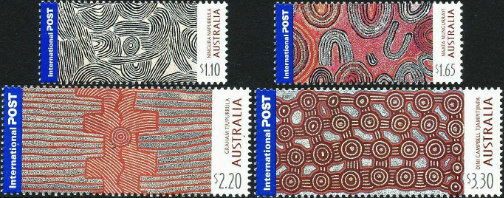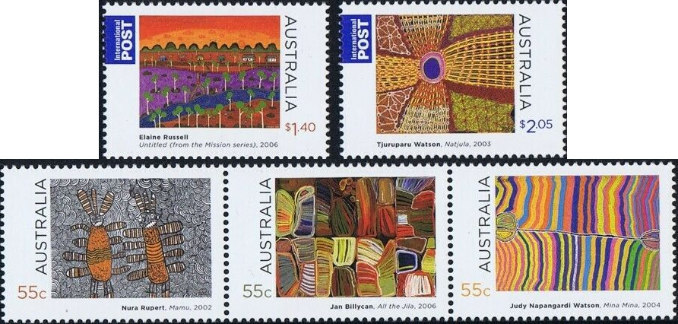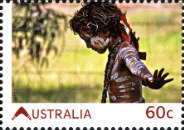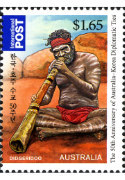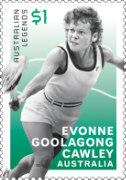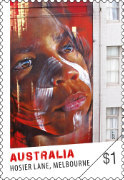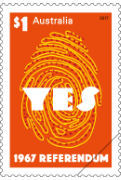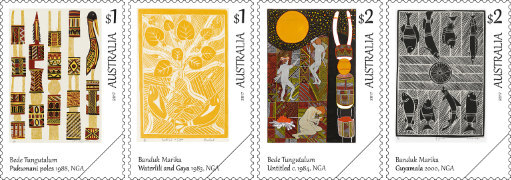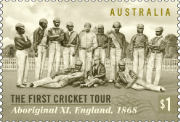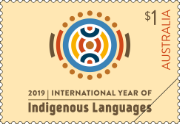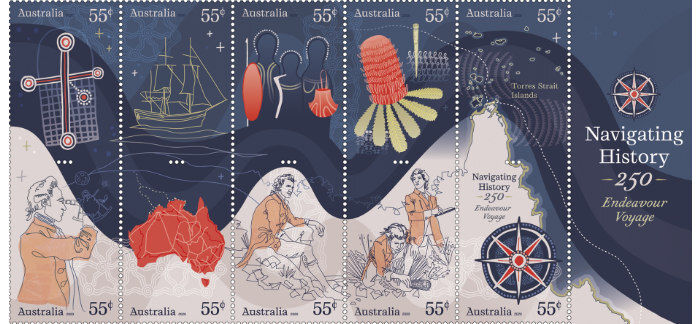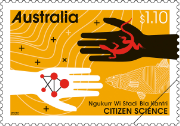Arts
Australian stamps celebrating Aboriginal culture
From the first Australian stamp showing an Aboriginal person to contemporary and beautifully designed stamps – this timeline shows them all.
Found 52 results for your search. Showing page 2 of 3.
1997
-
The stamps in this issue are images from four animations of The Dreaming series, a video series of 13 animated stories for children, released by the Australian Film Commission in 1995 and 1997.
The images show Dumbi the owl (based on a story by David Mowaljarlai of the Hibiscus people), The Two Willy-Willies (a story told by Josie Boyle from the desert people of the Wongi nation), How Brolga Became a Bird (a story told by Pauline McLeod from the Mutti Mutti people of Lake Mungo, NSW) and Tuggan Tuggan (Silky Oak) (a story told by Oodgeroo Noonuccal from Stradbroke Island).

Left to right: Dumbi the Owl; The Two Willy-Willies; How Brolga Became an Owl; Tuggan Tuggan.
2000
-

Portrait of young Cyril Watson. One of the 25 unique photographs of Australians from everyday life in the Faces of Australia issue is Cyril Watson, a young girl from remote Central Australia.
-

Stamp commemorating Cathy Freeman's win over 400m. Australia Post's Australian Gold Medallists issue shows the first stamp of a living Aboriginal person. Until 1997 no living person (Royal family excluded) was featured on Australia’s stamps. Athlete Cathy Freeman is the only Aboriginal person who has been individually honoured on a stamp in such a way.
-

The 45c stamp featured Cathy Freeman holding the Olympic torch. This stamp issue features Cathy Freeman lighting the Olympic Flame at the opening ceremony of the XXVII (27th) Olympic Games in Sydney. The stamp was voted the most popular in the 2000 Australia Post Stamp Poll.
2001
-

Stamp commemorating Yothu Yindi's song 'Treaty'. As part of its Rock Australia issue, Australia Post issues a stamp commemorating the 10th anniversary of Yothu Yindi’s song ‘Treaty’.
2002
-
Australia Post celebrates a centenary since the birth of Aboriginal artist Albert Namatjira on 28 July, 1902. He was the first Aboriginal artist to exhibit his work professionally and paint in a Western style.

Albert Namatjira's signature style features desert landscapes of Central Australia.
2003
-
Australia Post issues a set of stamps that celebrates the Papunya Tula school of art. The set shows four of the many artists: Ningura Napurrula (Pintupi, born c. 1938; $1.10), Naata Nungurrayi (Pintupi, born c. 1932; $1.65), Graham Tjupurrula (Pintupi, born 1975; $2.20) and Dini Campbell Tjampitjinpa (Pintupi, c.1945-2000; $3.30). All paintings are untitled.

The stamps show four paintings of artists of the Papunya Tula art movement.
2009
-
Australia Post releases five stamps featuring paintings by five Aboriginal artists: Nura Ripert (Mamu), Jan Billycan (All the Jila), Judy Napangardi Watson (Mina Mina), and for the international stamps Elaine Russell (Untitled [Mission Series]) and Tjuruparu Watson (Natjula).

The works of five Aboriginal artists represent Aboriginal culture on national and international stamps.
2011
-

To avoid stereotypes, Australia Post could have opted for a more contemporary representation of Aboriginal culture for this stamp. As part of its Living Australian issue Australia Post issues a stamp with the image of a young Aboriginal boy. The photo is titled Little Man's Business and was taken by Suzanne Wilson of New South Wales.
-

An identical stamp was issued in Korea to celebrate the relationship with Australia. Australia Post issues a stamp showing an Aboriginal didgeridoo player for the 50th anniversary of the Australian–Korean relationship which was forged during the Korean War. Official diplomatic relations begun in 1961 and developed into a strong partnership. The other stamp shows a Haegeum musician.
2013
-
Australia Post honours five “eminent” Aboriginal people in a stamp issue: Shirley Smith AM, Neville Bonner AO, Oodgeroo Noonuccal, Eddie “Koiki” Mabo and Charles Perkins AO.

All of these Aboriginal leaders have passed – be mindful of that when showing them to Aboriginal people.
2016
-

Tennis legend Evonne Goolagong-Cawley was the first Australian woman to win Wimbledon in 1971. One stamp of Australia Post's Australian Legends of Singles Tennis issue features Wiradjuri woman Evonne Goolagong Cawley AO MBE. She won four Australian Open singles between 1974 and 1977 and Wimbledon in 1971 and 1980. When she finished her career in the mid-1980s she had seven Grand Slam singles titles from 18 finals, and 13 major titles in all.
2017
-

Artist Adnate is well known for his giant art works which often feature Aboriginal subjects. One stamp in Australia Post's Street Art issue shows artist Adnate’s large-scale work in Hosier Lane, Melbourne. The City of Melbourne commissioned this 23 metre mural of an Aboriginal boy in 2014. As in this portrait, Adnate’s subjects are often members of Aboriginal communities, and the artist has done a significant amount of fundraising work in this area.
-

The stamp overlays two fingerprints and the iconic 'Yes' that marked the campaign. An Australia Post stamp commemorates the 50th anniversary of the 1967 referendum. On 27 May 1967, Australians voted to change the constitution to empower the federal government to make legislation for Aboriginal people, in the same way it could for all other Australians, and to include Aboriginal people in the census.
The stamp combines contemporary dot art elements and curved lines to form a symbol of two fingerprints merging to form one. The word "Yes" in the iconic referendum-campaign font symbolises strength in unity and what has been thus far achieved.
-
Since 1997 Australia Post celebrates living Australians who have positively shaped Australian society with its Australian Legends Award. In 2017 it honours three Aboriginal leaders: Tom Calma, Lowitja O’Donoghue and Galarrwuy Yunupingu for their tireless and lifelong efforts to improve social and economic outcomes for Aboriginal peoples. Together, their work has spanned the areas of land rights, economics, self-determination, health, welfare, education and reconciliation.
Since its inception, Australia Post announced the Australian Legends Award on Australia Day. Out of respect for those who associate 26 January with invasion and the colonisation of Aboriginal people, it scheduled this year's announcement to May, coinciding with the 50th anniversary of the 1967 referendum. [1]

Portraits of Aboriginal Elders Tom Calma, Lowitja O’Donoghue and Galarrwuy Yunupingu. -
Australia Post publishes a set of stamps themed 'Art of the North', featuring works by two Aboriginal artists from the northern regions of Australia’s Northern Territory, Banduk Marika and Bede Tungutalum. All works are part of the collection of the National Gallery of Australia.

Left to right: Bede Tungutalum's Pukumani Poles, Banduk Marika's Waterlili and Gaya, Tungutalum's Untitled and Marika's Guyamala 2000.
2018
-

The stamp shows one of the few remaining photos of the Aboriginal XI taken while on tour in 1868. The designer added the background. Australia Post commemorates the 150th anniversary of the first international cricket tour of England in 1868 by a team of 13 Aboriginal cricketers, most of whom were Jardwadjali, Gunditjmara and Wotjobaluk men from the Western District of Victoria. They played 47 matches, won 14, drew 19 and lost 14. A men's and women's Aboriginal XI squad went on a commemorative tour of England in June 2018 to celebrate the anniversary.
2019
-

The commemorative stamp design shows the official logo of the International Year of Indigenous Languages 2019. Australia Post issues a stamp commemorating the International Year of Indigenous Languages. There were at least 250 Aboriginal languages in Australia before invasion. Of the 120 or so languages that remain, about 100 are at risk of being lost. Only about 13 languages are alive as a first language spoken by the younger generation.
2020
-
A special set of oversized stamps celebrates the 250th anniversary of the Endeavour voyage. The "Navigating History" stamps were designed by Aboriginal artist Jenna Lee and Niqui Branchu from the creative agency Gilimbaa. Each stamp shows how Aboriginal and European narratives overlap in the context of the Endeavour voyage. The themes include sky, land, people, plants and the future. As Australia Post put it, "the visual narrative aims to create respect, insight and understanding of the multiple stories, lives and cultures that intersected at the time of the Endeavour’s Pacific voyage". [2]

The designers used bold red colour to illustrate Aboriginal stories and fine lines for European narratives. Note how the wavy dark blue band could almost represent the rainbow serpent, a key spiritual element in many Aboriginal teachings. -

The stamp is part of a set of four designed by Jonathan Chong. Australia Post issues a set of four stamps to promote four recent citizen science projects from Australia. Citizen science involves public participation and collaboration in scientific research with the aim of increasing scientific knowledge.
One stamp celebrates the Ngukurr Wi Stadi Bla Kantri ("We Study the Country" in the Kriol language) biodiversity project, a cross-cultural collaboration between the remote Aboriginal community of Ngukurr in south-east Arnhem Land and Macquarie University in Sydney.
The Ngukurr Wi Stadi Bla Kantri project started in 2010, bringing together the Yugul Mangi Rangers, most of the residents of Ngukurr and children at Ngukurr School. It helps equip Aboriginal Elders and youth with the knowledge and tools to better understand and manage South East Arnhem Land environments. Through the project, the team is re-discovering a large and remote area unknown to Western science and working towards maintaining endangered Aboriginal bio-cultural knowledge.
References
View article sources (0)
[103865] 'The Australia Post Legends 2017: Indigenous leaders', Australia Post 29/5/2017
[138596] 'Navigating History: Endeavour Voyage 250 Years', Australia Post 29/4/2020, available at australiapostcollectables.com.au/stamp-issues/navigating-history-endeavour-voyage-250-years.html

